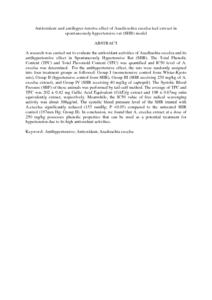Citation
A. S., Nur Farhana and S., Nurul ‘Izzati and S., Nurdiana and Rajion, M. A. and Goh, Y. M. and A., Mokrish and A., Hafandi
(2016)
Antioxidant and antihyper- tensive effect of Azadirachta excelsa leaf extract in spontaneously hypertensive rat (SHR) model.
HSOA Journal of Alternative, Complementary & Integrative Medicine, 2 (2).
pp. 1-4.
ISSN 2470-7562
Abstract
A research was carried out to evaluate the antioxidant activities of Azadirachta excelsa and its antihypertensive effect in Spontaneously Hypertensive Rat (SHR). The Total Phenolic Content (TPC) and Total Flavonoid Content (TFC) was quantified and IC50 level of A. excelsa was determined. For the antihypertensive effect, the rats were randomly assigned into four treatment groups as followed: Group I (normotensive control from Wistar-Kyoto rats),Group II (hypertensive control from SHR), Group III (SHR receiving
250 mg/kg of A. excelsa extract), and Group IV (SHR receiving 40 mg/kg of captopril). The Systolic Blood Pressure (SBP) of these animals was performed by tail-cuff method. The average of TPC and TFC was 202 ± 0.42 mg Gallic Acid Equivalent (GAE)/g extract and 198 ± 0.67 mg rutin equivalent/g extract, respectively. Meanwhile, the IC50
value of free radical scavenging activity was about 308μg/ml. The systolic blood pressure level of the SHR treated with A.excelsa significantly reduced (153 mmHg;
P <0.05) compared to the untreated SHR control (187 mm Hg; Group II). In conclusion, we found that A. excelsa extract at a dose of 250 mg/kg possesses phenolic properties that can be used as a potential treatment for hypertension due to its high antioxidant activities.
Download File
![[img]](http://psasir.upm.edu.my/55091/1.hassmallThumbnailVersion/Antioxidant%20and%20antihyper-%20tensive%20effect%20of%20Azadirachta%20excelsa%20leaf%20extract%20in%20spontaneously%20hypertensive%20rat%20%28SHR%29%20model.pdf)  Preview |
|
PDF (Abstract)
Antioxidant and antihyper- tensive effect of Azadirachta excelsa leaf extract in spontaneously hypertensive rat (SHR) model.pdf
Download (109kB)
| Preview
|
|
Additional Metadata
Actions (login required)
 |
View Item |

